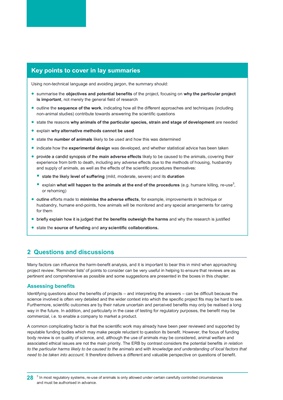
28
2 Questions and discussions
Many factors can influence the harm-benefit analysis, and it is important to bear this in mind when approaching
project review. 'Reminder lists' of points to consider can be very useful in helping to ensure that reviews are as
pertinent and comprehensive as possible and some suggestions are presented in the boxes in this chapter.
Assessing benefits
Identifying questions about the benefits of projects - and interpreting the answers - can be difficult because the
science involved is often very detailed and the wider context into which the specific project fits may be hard to see.
Furthermore, scientific outcomes are by their nature uncertain and perceived benefits may only be realised a long
way in the future. In addition, and particularly in the case of testing for regulatory purposes, the benefit may be
commercial, i.e. to enable a company to market a product.
A common complicating factor is that the scientific work may already have been peer reviewed and supported by
reputable funding bodies which may make people reluctant to question its benefit. However, the focus of funding
body review is on quality of science, and, although the use of animals may be considered, animal welfare and
associated ethical issues are not the main priority. The ERB by contrast considers the potential benefits in relation
to the particular harms likely to be caused to the animals and with knowledge and understanding of local factors that
need to be taken into account. It therefore delivers a different and valuable perspective on questions of benefit.
Key points to cover in lay summaries
Using non-technical language and avoiding jargon, the summary should:
summarise the objectives and potential benefits of the project, focusing on why the particular project
is important, not merely the general field of research
outline the sequence of the work, indicating how all the different approaches and techniques (including
non-animal studies) contribute towards answering the scientific questions
state the reasons why animals of the particular species, strain and stage of development are needed
explain why alternative methods cannot be used
state the number of animals likely to be used and how this was determined
indicate how the experimental design was developed, and whether statistical advice has been taken
provide a candid synopsis of the main adverse effects likely to be caused to the animals, covering their
experience from birth to death, including any adverse effects due to the methods of housing, husbandry
and supply of animals, as well as the effects of the scientific procedures themselves:
state the likely level of suffering (mild, moderate, severe) and its duration
explain what will happen to the animals at the end of the procedures (e.g. humane killing, re-use3
,
or rehoming)
outline efforts made to minimise the adverse effects, for example, improvements in technique or
husbandry, humane end-points, how animals will be monitored and any special arrangements for caring
for them
briefly explain how it is judged that the benefits outweigh the harms and why the research is justified
state the source of funding and any scientific collaborations.
3 In most regulatory systems, re-use of animals is only allowed under certain carefully controlled circumstances
and must be authorised in advance.